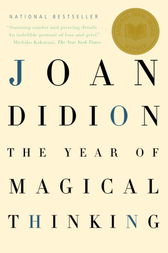In her book, The Year of Magical Thinking, Joan Didion describes the sudden loss of her husband, John G. Dunne (1932–2003) due to a heart attack. While reading it, what caught my attention more than anything else is Didion’s attention to details. The book is full of dates, numbers, names, and locations. Here is one example:
During the twenty-four December and January nights when Quintana was in the sixth-floor ICU at Beth Israel North I had kept on the table by my bed a paperback copy of Intensive Care: A Doctor’s Journal, by John F. Murray, M.D., who had been from 1966 to 1989 chief of the Pulmonary and Critical Care Division at the University of California medical school in San Francisco. Intensive Care describes, day by day, a four-week period in a San Francisco General Hospital medical ICY for which Dr. Murray was at the time the attending physician responsible for all patients, residents, interns, and medical students. I had read this account over and over. I had learned much that proved useful in the calibration of my daily dealings with the ICU doctors at Beth Israel North.
Twenty-four nights. Sixth floor. Paperback copy. 1966 to 1989. Four-week period. And, rather than “patients and staff”, we read “patients, residents, interns, and medical students.”
Imagine a person who is barely able to remain standing on her feet, barely holding her balance, grasping at walls and door handles in order to keep up, keep on her feet, keep the ability to survey the environment. Didion’s constant grasping at details, distinctions, and particularities is like that person’s grasping at physical support. She reminds herself:
Read, learn, work it up, go to the literature.
Information is control.
When she writes, “control”, she is referring to something much more intimate and urgent than having control over objects and events in an outside world. She uses the word, “calibration,” which I think is key. Her attentiveness to detail is indiscriminate. She has become hyper-vigilant and hyper-attentive against a world that has shocked and traumatized her. Selective attention, occasional attentiveness to some details is a luxury, for which she cannot feel safe enough. We read about her going through scientific studies about bereavement or research with a brain surgery procedures, relevant to what her daughter Quintana is going through. She notes not only the general conclusion drawn from the study, but the names, dates, number of patients, percentages, what percentages mean in terms of number of people.
My heart is filled with admiration for her mind, and for the effort (of which she has kept these records). She has an incredibly powerful mind, made visible on the pages of this book, made visible through the struggle. We read and see how her mental power is summoned and used in self-preservation. She goes back and forth, in all directions, she thinks, she feels, she wonders: Did he know that he was dying? Why did he give me back the note and say, “you can use it if you want”? Her mind moves in all directions, now taking a step back, trying to reflect, now immersing again in the haze of intense emotions, now remembering a past event, now paying attention to what is in front of her. She remains standing, she keeps going, and keeps seeing. As she continues seeing, the world and her mind both transform, moving with the hope of a future sense.
I’ll continue reading–and possibly writing about–The Year of Magical Thinking. And I’d like to acknowledge Mary Margaret, whose videos introduced me to Joan Didion and her work.
